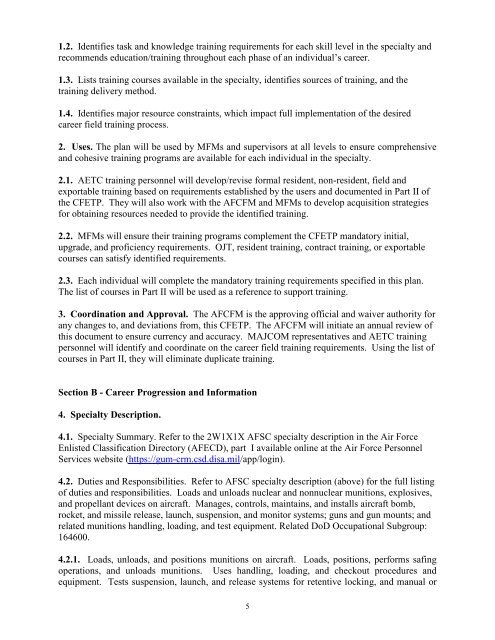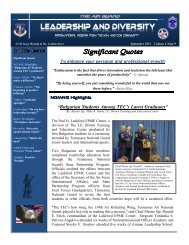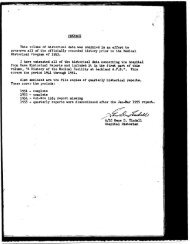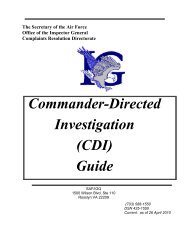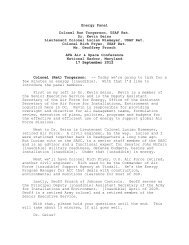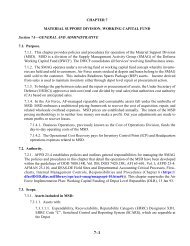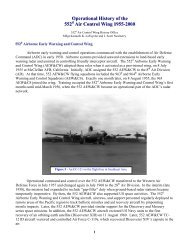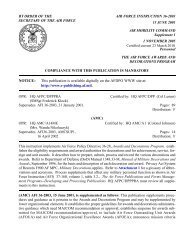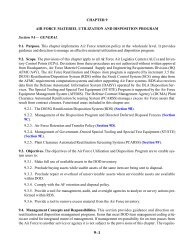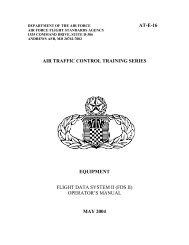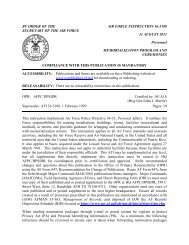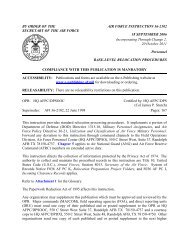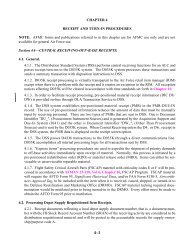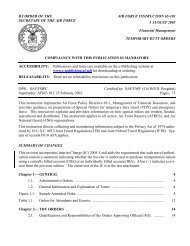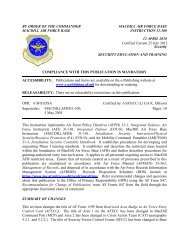AFSC 2W1X1 AIRCRAFT ARMAMENT SYSTEMS ... - Air Force Link
AFSC 2W1X1 AIRCRAFT ARMAMENT SYSTEMS ... - Air Force Link
AFSC 2W1X1 AIRCRAFT ARMAMENT SYSTEMS ... - Air Force Link
Create successful ePaper yourself
Turn your PDF publications into a flip-book with our unique Google optimized e-Paper software.
1.2. Identifies task and knowledge training requirements for each skill level in the specialty and<br />
recommends education/training throughout each phase of an individual’s career.<br />
1.3. Lists training courses available in the specialty, identifies sources of training, and the<br />
training delivery method.<br />
1.4. Identifies major resource constraints, which impact full implementation of the desired<br />
career field training process.<br />
2. Uses. The plan will be used by MFMs and supervisors at all levels to ensure comprehensive<br />
and cohesive training programs are available for each individual in the specialty.<br />
2.1. AETC training personnel will develop/revise formal resident, non-resident, field and<br />
exportable training based on requirements established by the users and documented in Part II of<br />
the CFETP. They will also work with the AFCFM and MFMs to develop acquisition strategies<br />
for obtaining resources needed to provide the identified training.<br />
2.2. MFMs will ensure their training programs complement the CFETP mandatory initial,<br />
upgrade, and proficiency requirements. OJT, resident training, contract training, or exportable<br />
courses can satisfy identified requirements.<br />
2.3. Each individual will complete the mandatory training requirements specified in this plan.<br />
The list of courses in Part II will be used as a reference to support training.<br />
3. Coordination and Approval. The AFCFM is the approving official and waiver authority for<br />
any changes to, and deviations from, this CFETP. The AFCFM will initiate an annual review of<br />
this document to ensure currency and accuracy. MAJCOM representatives and AETC training<br />
personnel will identify and coordinate on the career field training requirements. Using the list of<br />
courses in Part II, they will eliminate duplicate training.<br />
Section B - Career Progression and Information<br />
4. Specialty Description.<br />
4.1. Specialty Summary. Refer to the <strong>2W1X1</strong>X <strong>AFSC</strong> specialty description in the <strong>Air</strong> <strong>Force</strong><br />
Enlisted Classification Directory (AFECD), part I available online at the <strong>Air</strong> <strong>Force</strong> Personnel<br />
Services website (https://gum-crm.csd.disa.mil/app/login).<br />
4.2. Duties and Responsibilities. Refer to <strong>AFSC</strong> specialty description (above) for the full listing<br />
of duties and responsibilities. Loads and unloads nuclear and nonnuclear munitions, explosives,<br />
and propellant devices on aircraft. Manages, controls, maintains, and installs aircraft bomb,<br />
rocket, and missile release, launch, suspension, and monitor systems; guns and gun mounts; and<br />
related munitions handling, loading, and test equipment. Related DoD Occupational Subgroup:<br />
164600.<br />
4.2.1. Loads, unloads, and positions munitions on aircraft. Loads, positions, performs safing<br />
operations, and unloads munitions. Uses handling, loading, and checkout procedures and<br />
equipment. Tests suspension, launch, and release systems for retentive locking, and manual or<br />
5


